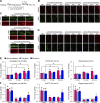Active Transition of Fear Memory Phase from Reconsolidation to Extinction through ERK-Mediated Prevention of Reconsolidation
- PMID: 33293359
- PMCID: PMC7888227
- DOI: 10.1523/JNEUROSCI.1854-20.2020
Active Transition of Fear Memory Phase from Reconsolidation to Extinction through ERK-Mediated Prevention of Reconsolidation
Abstract
The retrieval of fear memory induces two opposite memory process, i.e., reconsolidation and extinction. Brief retrieval induces reconsolidation to maintain or enhance fear memory, while prolonged retrieval extinguishes this memory. Although the mechanisms of reconsolidation and extinction have been investigated, it remains unknown how fear memory phases are switched from reconsolidation to extinction during memory retrieval. Here, we show that an extracellular signal-regulated kinase (ERK)-dependent memory transition process after retrieval regulates the switch of memory phases from reconsolidation to extinction by preventing induction of reconsolidation in an inhibitory avoidance (IA) task in male mice. First, the transition memory phase, which cancels the induction of reconsolidation, but is insufficient for the acquisition of extinction, was identified after reconsolidation, but before extinction phases. Second, the reconsolidation, transition, and extinction phases after memory retrieval showed distinct molecular and cellular signatures through cAMP responsive element binding protein (CREB) and ERK phosphorylation in the amygdala, hippocampus, and medial prefrontal cortex (mPFC). The reconsolidation phase showed increased CREB phosphorylation, while the extinction phase displayed several neural populations with various combinations of CREB and/or ERK phosphorylation, in these brain regions. Interestingly, the three memory phases, including the transition phase, showed transient ERK activation immediately after retrieval. Most importantly, the blockade of ERK in the amygdala, hippocampus, or mPFC at the transition memory phase disinhibited reconsolidation-induced enhancement of IA memory. These observations suggest that the ERK-signaling pathway actively regulates the transition of memory phase from reconsolidation to extinction and this process functions as a switch that cancels reconsolidation of fear memory.SIGNIFICANCE STATEMENT Retrieval of fear memory induces two opposite memory process; reconsolidation and extinction. Reconsolidation maintains/enhances fear memory, while extinction weakens fear memory. It remains unknown how memory phases are switched from reconsolidation to extinction during retrieval. Here, we identified an active memory transition process functioning as a switch that inhibits reconsolidation. This memory transition phase showed a transient increase of extracellular signal-regulated kinase (ERK) phosphorylation in the amygdala, hippocampus and medial prefrontal cortex (mPFC). Interestingly, inhibition of ERK in these regions at the transition phase disinhibited the reconsolidation-mediated enhancement of inhibitory avoidance (IA) memory. These findings suggest that the transition memory process actively regulates the switch of fear memory phases of fear memory by preventing induction of reconsolidation through the activation of the ERK-signaling pathway.
Keywords: ERK; extinction; fear memory; reconsolidation; transition.
Copyright © 2021 the authors.
Figures








Similar articles
-
Brain region-specific gene expression activation required for reconsolidation and extinction of contextual fear memory.J Neurosci. 2009 Jan 14;29(2):402-13. doi: 10.1523/JNEUROSCI.4639-08.2009. J Neurosci. 2009. PMID: 19144840 Free PMC article.
-
Enhancement of fear memory by retrieval through reconsolidation.Elife. 2014 Jun 24;3:e02736. doi: 10.7554/eLife.02736. Elife. 2014. PMID: 24963141 Free PMC article.
-
Extinction, applied after retrieval of auditory fear memory, selectively increases zinc-finger protein 268 and phosphorylated ribosomal protein S6 expression in prefrontal cortex and lateral amygdala.Neurobiol Learn Mem. 2014 Nov;115:78-85. doi: 10.1016/j.nlm.2014.08.015. Epub 2014 Sep 6. Neurobiol Learn Mem. 2014. PMID: 25196703
-
Brain sites involved in fear memory reconsolidation and extinction of rodents.Neurosci Biobehav Rev. 2015 Jun;53:160-90. doi: 10.1016/j.neubiorev.2015.04.003. Epub 2015 Apr 14. Neurosci Biobehav Rev. 2015. PMID: 25887284 Review.
-
Interaction between reconsolidation and extinction of fear memory.Brain Res Bull. 2023 Apr;195:141-144. doi: 10.1016/j.brainresbull.2023.02.009. Epub 2023 Feb 16. Brain Res Bull. 2023. PMID: 36801360 Review.
Cited by
-
Selective δ-Opioid Receptor Agonist, KNT-127, Facilitates Contextual Fear Extinction via Infralimbic Cortex and Amygdala in Mice.Front Behav Neurosci. 2022 Feb 21;16:808232. doi: 10.3389/fnbeh.2022.808232. eCollection 2022. Front Behav Neurosci. 2022. PMID: 35264937 Free PMC article.
-
The Expression of Epac2 and GluA3 in an Alzheimer's Disease Experimental Model and Postmortem Patient Samples.Biomedicines. 2023 Jul 25;11(8):2096. doi: 10.3390/biomedicines11082096. Biomedicines. 2023. PMID: 37626593 Free PMC article.
-
Neurogenic Interventions for Fear Memory via Modulation of the Hippocampal Function and Neural Circuits.Int J Mol Sci. 2022 Mar 25;23(7):3582. doi: 10.3390/ijms23073582. Int J Mol Sci. 2022. PMID: 35408943 Free PMC article. Review.
-
Windows of change: Revisiting temporal and molecular dynamics of memory reconsolidation and persistence.Neurosci Biobehav Rev. 2025 Jul;174:106198. doi: 10.1016/j.neubiorev.2025.106198. Epub 2025 May 10. Neurosci Biobehav Rev. 2025. PMID: 40354954 Review.
-
Prelimbic proBDNF Facilitates Retrieval-Dependent Fear Memory Destabilization by Regulation of Synaptic and Neural Functions in Juvenile Rats.Mol Neurobiol. 2022 Jul;59(7):4179-4196. doi: 10.1007/s12035-022-02849-9. Epub 2022 Apr 30. Mol Neurobiol. 2022. PMID: 35501631
References
Publication types
MeSH terms
LinkOut - more resources
Full Text Sources
Miscellaneous
